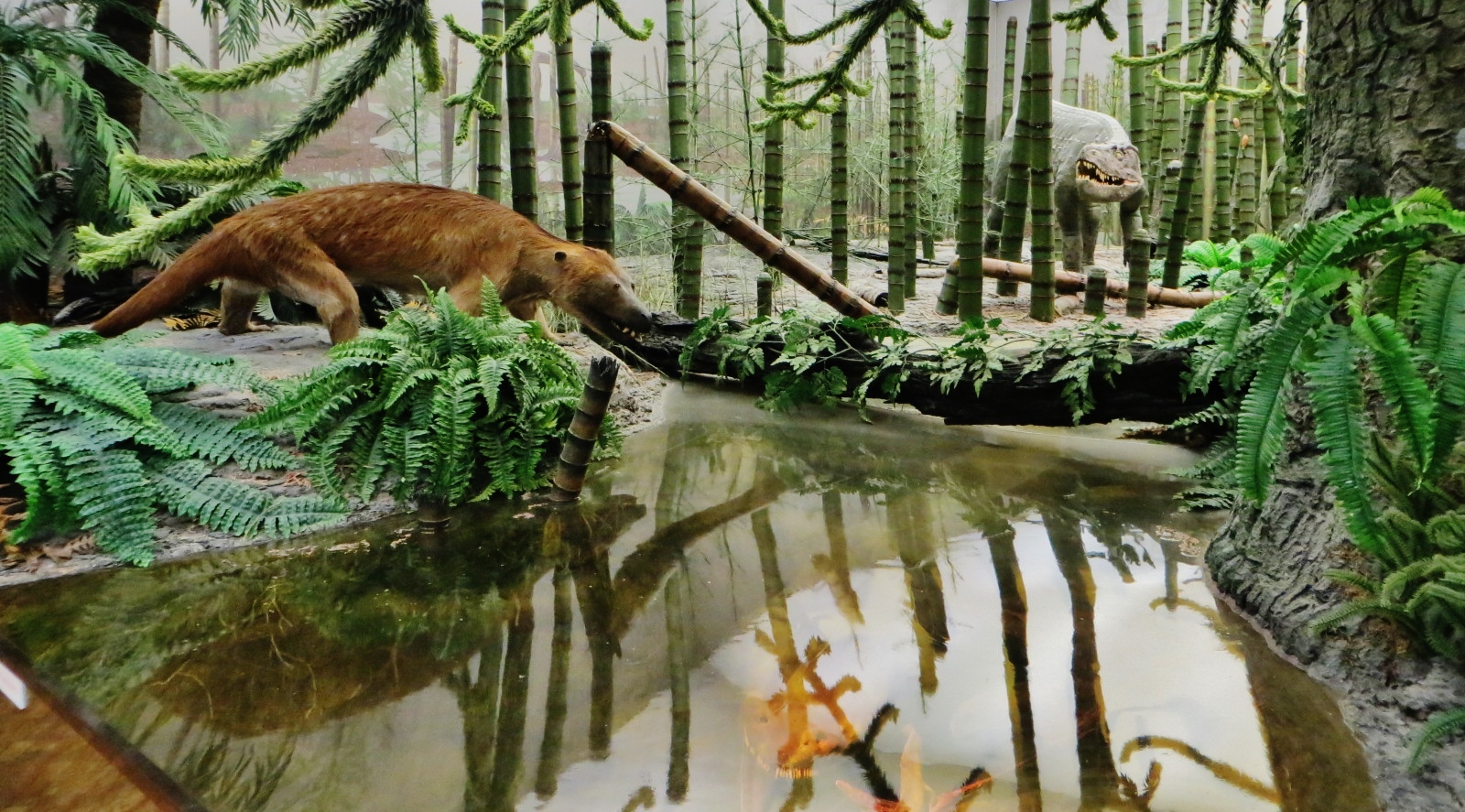Picture the scene 237 million years ago, in the hot Pangaean sun. Dinosaurs rule the land; sauropods, their long necks stretching like snakes towards the sky, browsed on foliage. Dagger-toothed predators, such as Coelophysis, ensured that life was short for anything made of meat. In those days, stem-group mammals had to be small, proficient scuttlers. Anything four-legged that walked about on land was either a big dinosaur, a predator, or lunch.
Or so we thought.
An incredible discovery was published last Thursday: a giant dicynodont, the size of an elephant and built like a rhinoceros. Its fossil skeleton was found in the village of Lisowice in Poland; it has been named Lisowicia bojani. Previous dicynodont fossils showed them to be small, vegetarian, mammal-like reptiles; L. bojani is the biggest one yet. Weighing in at nine tonnes, it was heavier than most African elephants, and spectacularly contradicts our prior understanding that all large herbivores were dinosaurs.
Dicynodonts, also known as proto-mammals or stem-group mammals, were a diverse and successful group of reptiles. However, they were a far cry from today's snakes, lizards, crocodiles and turtles: in fact, if you saw a dicynodont at the zoo you would probably think it was a strange mammal. Built like tanks, the dicynodonts were a branch of the therapsid lineage, which eventually gave rise to mammals. Most dicynodonts resemble small hippos, some with tusks (the name dicynodont means "two dog teeth"), and scientists previously thought that the success of the dinosaurs had forced the stem-group mammals to stay small. However, L. bojani forces us to rethink how complex the interactions between different mammals and other land animals were.
Of course, L. bojani was not the only heavyweight around. The six-metre long, ridiculously-proportioned Tanystropheus, for example, probably lived near the water and ate fish. With a neck longer than its body and tail combined, Tanystropheus appears to have had a large mass of flesh near its bottom to maintain a sensible centre of gravity.
More terrifying non-dinosaurs also existed during the Triassic: Rauisuchia was a genus of large, predatory reptiles that may have out-competed theropod dinosaurs as the baddest cats around. More closely related to crocodiles and birds than mammals, Rauisuchia's bony eye sockets, curved, pointed teeth, and large, muscular head are the stuff of nightmares.
Much as we like to think of the Triassic as the realm of the dinosaurs, sometimes new discoveries such as L. bojani force us to remember that they were really only part of a complex ecosystem which included stem-group mammals and other reptiles. Dinosaurs may have reached massive sizes and dominated the land in the Jurassic, but there is evidence that plenty of other four-legged land animals were pretty darn impressive too.
Or so we thought.
An incredible discovery was published last Thursday: a giant dicynodont, the size of an elephant and built like a rhinoceros. Its fossil skeleton was found in the village of Lisowice in Poland; it has been named Lisowicia bojani. Previous dicynodont fossils showed them to be small, vegetarian, mammal-like reptiles; L. bojani is the biggest one yet. Weighing in at nine tonnes, it was heavier than most African elephants, and spectacularly contradicts our prior understanding that all large herbivores were dinosaurs.
Dicynodonts, also known as proto-mammals or stem-group mammals, were a diverse and successful group of reptiles. However, they were a far cry from today's snakes, lizards, crocodiles and turtles: in fact, if you saw a dicynodont at the zoo you would probably think it was a strange mammal. Built like tanks, the dicynodonts were a branch of the therapsid lineage, which eventually gave rise to mammals. Most dicynodonts resemble small hippos, some with tusks (the name dicynodont means "two dog teeth"), and scientists previously thought that the success of the dinosaurs had forced the stem-group mammals to stay small. However, L. bojani forces us to rethink how complex the interactions between different mammals and other land animals were.
Of course, L. bojani was not the only heavyweight around. The six-metre long, ridiculously-proportioned Tanystropheus, for example, probably lived near the water and ate fish. With a neck longer than its body and tail combined, Tanystropheus appears to have had a large mass of flesh near its bottom to maintain a sensible centre of gravity.
More terrifying non-dinosaurs also existed during the Triassic: Rauisuchia was a genus of large, predatory reptiles that may have out-competed theropod dinosaurs as the baddest cats around. More closely related to crocodiles and birds than mammals, Rauisuchia's bony eye sockets, curved, pointed teeth, and large, muscular head are the stuff of nightmares.
Much as we like to think of the Triassic as the realm of the dinosaurs, sometimes new discoveries such as L. bojani force us to remember that they were really only part of a complex ecosystem which included stem-group mammals and other reptiles. Dinosaurs may have reached massive sizes and dominated the land in the Jurassic, but there is evidence that plenty of other four-legged land animals were pretty darn impressive too.
 |
| Maybe his massive cousin could have stepped in to defend him? Image credit: Ghedoghedo |

Comments
Post a Comment